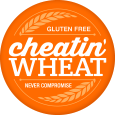- Oct 10, 2013
Maybe it is because I am gluten free, but it feels like gluten free is on its way to becoming a cultural norm. Groceries, restaurants, websites, blogs, breweries, labeling laws... And yet the question I still get asked at least once a week is, "What is gluten?" More importantly, this question is often being asked by someone who is living gluten free.
On the surface this is a really easy answer. Gluten is a combination of two proteins, gliadin and glutenin, that are found in all forms of wheat including durum, semolina, spelt, kamut, bulgur, einkorn and farro. It is also found in related grains such as barley, rye and triticale. See wasn't that helpful?
However, I have come to discover just how complex this really is. You see, wrapped up in this simple little question are implied concerns about life going forward. Things like:
"What am I supposed to eat?"
"What do I have to give up?"
"Am I going to be able to eat out?"
"What beverages are off limits?"
"Is eating gluten free going to be more expensive?"
And this is just a handful of the concerns. I could write until my fingers were numb and not answer these and other important questions fully for every person. What I can do is give you a concise answer to some common concerns.
What foods contain gluten?
First, you must always read labels carefully. My mantra is "Every Label! Every Time!" I know, it is easy to get complacent when it comes to reading labels and identifying which foods have gluten in them. You find a product you like, it is gluten free and then you stop looking so hard each time you repeat buy. However, manufactured foods can change ingredients and ingredient sources frequently so you must always be diligent. It is also important to note that food labels must specify if they contain wheat, but not barley, rye, etc. This means food can be wheat free but not gluten free.
1. All foods made with wheat flour. This includes things like breads, cookies, cakes, pancakes, flour tortillas, etc.
2. All foods made with barley, including barley malt. Barley sneaks up on you in items like beer, Rice Krispies, butterscotch baking chips, etc.
3. There are gluten containing "grains" that are made from wheat that do not have wheat in the name. Avoid bulgur, couscous, kasha and orzo.
4. Any food containing graham flour or matzo.
5. Oats are tricky and may contain gluten. Read more about whether oats are safe for a gluten free diet.
6. Gluten is found in many pre-packaged foods as a binder, filler or thickener. Read labels carefully on deli meats, salami, soups, gravies, sauces, dry spices/seasoning mixes, candy, etc.
7. Many sauces contain gluten, such as soy sauce, bbq sauce, marinades and salad dressings.
8. Surprisingly, many Bloody Mary drink bases contain gluten so read beverage labels too.
9. Gluten can sneak into foods under other names such as "Caramel Color", "Natural or Artificial Flavors", "Modified Food Starch", etc.
What is cross-contamination?
Cross-contamination is when a food that normally does not contain gluten comes in contact with gluten during its processing or preparation, changing it to a gluten containing item. This can occur by using the same utensils to cut both gluten free and non gluten free foods, frying gluten free foods in the same oil as flour based batters, having an excessive amount of flour in the air while preparing gluten free foods, etc. Cross-contamination is at the root of many concerns when dining out. However, you can take control of your own home with these tips on how to avoid cross-contamination.
Is eating gluten free really healthier?
Boy, is this a loaded question. There are many ways to live gluten free. You can fill your kitchen, your life, your body with fruits, vegetables, meat, fish, legumes, etc. and have a healthy diet. Or you could eat chips, ice cream, candy bars, processed foods, etc. and feel lousy. Obviously, there is a happy medium, but eating gluten free does not automatically dictate a healthy approach to food.
Is gluten free food more expensive?
Again, a tricky thing to answer. Most "real" food found in the grocery is naturally gluten free and you will be paying the same price as everyone else. I am talking about shopping for things like fruit, vegetables, meat, poultry, fish, eggs, dairy, rice, beans, lentils, etc. So, if this is how you shop, your grocery bill will not change much. An apple is an apple is an apple. However, if you purchase a lot of pre-made and pre-packaged products, the gluten free counterpart is often more expensive than its wheat based cousin. This includes things like cookies, bread, crackers, pasta, etc.
Why are gluten free foods more expensive?
The truthful, short answer is care and consideration. Yes, gluten free foods often contain an assortment of grains and starches that are more expensive then wheat. However, this is not the most expensive element of the equation. In order to be considered gluten free, every ingredient used to make that food has to be traceably gluten free through every step of processing; from the farm to the mill to the manufacturing facility to packaging. Gluten free food producers cannot just source ingredients from the cheapest or easiest supplier. A lot more effort must go into ensuring a food labeled gluten free actually is and this cost money.





 Find our products
Find our products FAQs
FAQs Testimonials
Testimonials R&D Projects
R&D Projects